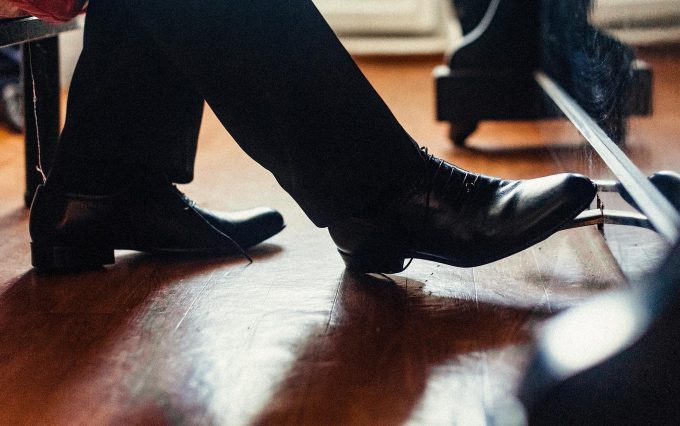
20th October 2022
Non-Fiction
12 minutes read
Praise of God in Solitude: A Pianist’s Faith in Life and Death

20th October 2022
12 minutes read
When I was in high school, a few classmates stood behind me in the open doorway of a claustral and windowless practice room that contained a concert grand piano. These young fellows – all students of instruments other than the piano – looked over my shoulder while I played to them from the Paderewski edition of Chopin’s nocturnes. One observant member of the group stopped me and challenged my reading of the score. Was I not violating many of the brief but notated rests, and unduly prolonging notes of short duration, by depressing the damper pedal (which activates a mechanism that permits all of the piano’s strings to vibrate freely) at the same time that I took such care to observe with my fingers those rests and notes?
I read to my challenger from the remarks at the back of the score:
“The pedal marks given by the Editorial Committee are strictly in accordance with the manuscripts and original editions.” This argued that the contradiction my fellow student had discovered should be attributed to the composer. I read further to him from the same editorial notes: “In any case, the use of the pedal is a very delicate and entirely individual matter, depending on many factors, such as instrument, touch, tempo or acoustics of the room.” In other words, the contradictions he had observed could be extended beyond those called for by Chopin. It was, indeed, an “entirely individual matter.” By the 1830s, a pianist who engaged the piano’s damper pedal for a protracted time but at the same time manually observed rests and notes of brief duration practiced a contradiction that was not a hypocrisy.
This did not satisfy my challenger at all. At last, I could not resist agreeing with him. Because for centuries now notation on the staff has remained so frequently in conflict with coinciding notation for the damper pedal (and in conflict with the damper pedal’s use persisting as an “entirely individual matter”), I have, since high school, spent decades suspecting that an elusive and perhaps extra-musical meaning lurks in the preservation of this contradiction. Indeed, something more than musical values must fuel the preservation of this incongruity, for I have rarely encountered a musician or pianist who has found it strange that since the early nineteenth-century, composers of piano music have continued to take the greatest care in notating rests and durations, and to expect that a player will observe those markings with painstaking faithfulness with the fingers, only then to expect the same player to contradict those markings by use of the damper pedal – to the extent that the result could cause even the most accomplished aural transcriber (out of sight of the score and the performer’s hands) to notate a representation very different from the composer’s original.
This mystery can be detected from the start of one’s study of the piano.
After a teacher is certain that a beginning pupil will endeavor first to maintain legato with the fingers, the pedal is introduced, almost as a reward. An observant beginner will soon note that a sort of reckless legato is a byproduct of the damper pedal. At the same time, use of the damper pedal just as quickly hints at a host of ulterior consequences and mysterious intimations. Notes seem less connected, one to the other, by the damper pedal’s use than made to overlap, like shingles on a roof: an adjacency so extreme it starts to form mutual occupations of space if not incipient verticalities. When applying the damper pedal to a note, one is reminded that Plato defines a line to be a flowing point. But points made to flow do not provide connectivity between flowing points – no more than do the long June shadows serve, in the forest at the golden hour, to connect solidly the trees; the squirrels cannot rely on those shadows to bridge their journeys from trunk to trunk. They must leap, notwithstanding the false bridges of the shadows, mindful still of the actual gulfs, or claw from adjacent and neighboring branches with the care and caution of a fingered legato.
I begin to ask the seemingly unanswerable: Where in my life beyond the piano, with the activation of a figurative damper pedal, do I encourage, say, a previously articulated sound to cover the care I then take to observe a subsequent silence? Where else do I permit figurative damper pedals to stand as if for the role of body language transformed redundantly to sound? Where else, in any arena, do I activate figurative damper pedals? Where else do I sense this contradiction?
The answer may lie in an extra-musical sphere, at last, but the solution still remains within the realm of sound. There is a window just out of sight of the desk where I now write these lines. When that window is open but hidden from my eyes, I am reminded through my ears alone of my interest in the sound of a distant radio on a summer day: a sound depleted of all resonance. I experience a similar fascination for that effect when I note the background sound of a radio on a beach, just before the attack on the Kitner boy in the film Jaws. When eating recently in an acoustically dry pizza parlor,
I could hear Elvis Presley’s recording of “Blue Suede Shoes” sounding, at a low volume, behind the chatter in the restaurant.
The conditions had robbed the performance of its recorded resonance, of the ambient sound of the space in which the recording had been made. But perhaps most of all, hearing acoustic music performed in the complete absence of ambience, under a dry and open sky, triggers my belief that the first clue in the resolution of the great contradiction is then presented to me. I suspect that even the first reverberant auditoriums were created, not to shield us from the inclemency of actual rain, but from the aural dryness I cite just above, and then the piano’s damper pedal makes the pianist an architect of a still greater reverberance than that enwrapping the performer in such resonant spaces. The damper pedal thus doubles, triples, quadruples the resonant chambers around the thinking performer – the parenthetical depth depending solely on the courage exercised through the performer’s right foot. This external parenthetical resonance stands, then, as an emblem for a still greater (and, at last, infinite) parenthetical resonance: the Parenthetical Consciousness that lies within the performer’s mind. Thus, the longer the external damper pedal is activated, the more the ceaselessly growing concentricity of the player’s Parenthetical Consciousness is revealed.
That consciousness grows for as long as its mortal span permits, but it is contained within a performer who still must honor rests, durations, and articulations in the world outside of that inner consciousness. Even when I am standing, and away from the piano, I catch myself raising my right foot in emblematic gestures, and thus signal my conclusion to keep appointments, honor boundaries and sequence, respect silences, and observe the Ten Commandments. Culture and conscience demand intermittent lifting of the right foot. But notwithstanding the care and punctuality of our outward hands upon all actual and figurative keyboards, to the Parenthetical Consciousness it is, again, as if a sort of damper pedal is always activated and dampers are always raised, and thus one is tardy and timely, lawless and lawful, at once within.
Yet at all times the Parenthetical Consciousness dares the actual right foot to lengthen activation of the external damper pedal. And thus from the application of the damper pedal to the dry and careful print of the hands comes a palimpsest of cursive. My right foot in all hours is as an agent transfixed with a reckoning between the external and the internal.
Think of the implications, then, of this scenario: I have been told on good authority that once, as part of a lesson, Vladimir Horowitz pedaled for a gifted student while the latter played, only with his hands, Liszt’s “Bénédiction de Dieu dans la Solitude.” I submit that this ostensible division of labor still had one hearing the full consciousness of Horowitz. And then one is led to wonder, in four-hand duets at one piano, is not the one who is pedaling an entirety who is masquerading as a half?
One can only praise God in solitude.
The longer I hold down the damper pedal, the longer I sit between two mirrors that face and reflect endlessly the other: the pedaled sound I produce a reflection of my Parenthetical Consciousness; my Parenthetical Consciousness reflecting in turn my pedaled outer sound. Yet I am never crowded off of the bench by the accumulations of infinity. As Emanuel Swedenborg observes in A Treatise Concerning Heaven and Its Wonder, and Also Concerning Hell: “The more angels, the more room.”
The longer I depress the damper pedal, the more I project outward my Parenthetical Consciousness’ concurrent wrestlings and quick reconciliations with the piece then in performance: all other realizations of tempi, all recollected wrong notes, large parallel sections and textures that reappear in different keys, past parts, passages yet unplayed, fragments of past performances, even other pieces and experiences; all this heard by the Parenthetical Consciousness in an involuntary and non-sequential manner whilst one endeavors to render a perfect sequence with the fingers. The damper pedal then renders a high burlesque of the player’s insides escaping outward. With the hand we maintain a hold on the sequential in all things measurable. With the pedal we engage in a wondrous contradiction against such things. Activation of the damper pedal perpetuates not only all the notes sounded by the player via the keys since the pedal’s depression, but also, latently, all of the notes of the piano, and thus all of the notes that have already been played and have yet to be played. Even when playing no notes at all, at the moment of the activation of the damper pedal one hears a subtle but audible, hushed and whiskery, pan-register zing from all of the piano’s strings. Thus, as the Parenthetical Consciousness basks in a freedom from sequence within, activation of the pedal serves as its mirror and reveals the vulnerability of the ostensibly rigid sequence of any score, and thus of all external events – and suggests that it may raise the veil of threat from all destructive aspects of cause and effect.
Thus, as well, pedaling becomes a lampoon of the art of practicing, for it reveals, to a degree, that the cleaner we play with the fingers, the less we represent our inner selves.
Our practicing can then start to seem a madness, as if we endeavor to hide our consciousness by the most careful renderings of the hand.
We clean so vigorously and harshly in our practicing, in fact, it is as if we thereby engender scratches in the windows that look inward, and we make them increasingly opaque by reinforcement of our polishing. Yet, depress the damper pedal and throw open these windows!
But what prevents us from unremittingly depressing the damper pedal? Why lift and reset its effect so often in performance? Imagine, say, the pianist as a sort of locomotive with an ever-growing consist of cars both ahead and behind: endless tenders of Parenthetical Consciousness trailed and pushed at once. I think of this when I ride the Long Island Railroad and approach Jamaica Station, for at the approach to the platform is a placard with a warning for the engineer: CHECK CONSIST SIZE. Do we check our own consist size when we lift the damper pedal before an audience, for fear that the length of our Parenthetical Consciousness will outstretch the passenger platform and thus baffle any fellow man who can never board the full span of the train we would present?
But I do not think it is in reaction to one’s listeners that one, at last, repeatedly depresses and releases the damper pedal in a performance. One feels compelled to follow this cycle even in solitude. Why?
We depress the pedal and raise the dampers (and thus create the contradiction against the work of our mortal hands) in honor of our inner glimpse of a Godly blur of Omniscience. But God lowers dampers at last on our Parenthetical Consciousness, to protect us from reaching Impersonality and its stasis, the price of his fully realized Omniscience. Thus we depend on death for the character of our very lives.
When we raise the pedal and thus lower the dampers in our own playing, it is so as to pay homage to this gift of mortality from God, this gift that grants the further gift that God cannot recover for himself: Personality, and thus singular point of view, and thus the gift of mystery which inspires a finite individual toward the assembly of metaphors. Is it a coincidence that the sign given often in a score for the lifting of the damper pedal is an asterisk, that little and mortal star?
It fascinates me that one can practice on a piano if the damper pedal is broken in such a way that the dampers cannot be raised with the pedal. This hints to me that we cherish mortality and character more than we know. For I have never known myself to tolerate practicing on a piano if the damper pedal is broken in such a way that the dampers cannot be lowered. We leave the latter to God.
God is as an organist who sleeps with his brow and limbs draped across the ever-sounding manuals in heaven.
He leaves us awake for the mortal day in the nursery below, with the engaging rattle of the piano in our little fingers, but leaves us to put our foot down should we wish to peek on our guardian in the loft.







